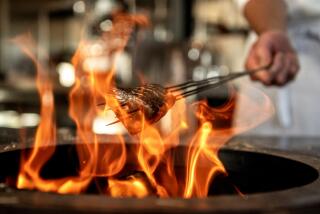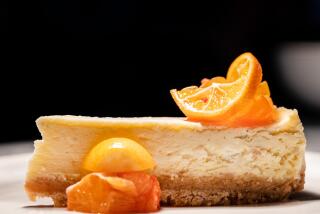The Isle of Edam
- Share via
This is a story about a cheese, an island and a dish born of two continents. The cheese, a smooth, butter-colored beauty from Holland, is called Edam. The island is another Dutch beauty, the crown jewel of the Dutch Antilles: Curacao.
The dish bears the curious name of keshi yena (pronounced kay-shee YAY-na). It’s a perfect symbol of the extraordinary cultural intermingling that characterizes Caribbean cooking.
Our story begins in the 13th Century in the village of Edam in northern Holland, where Dutch farmers perfected a cheese that would bring their town international acclaim. It’s a curious cheese, made with whole milk from the morning milking and skim milk from the night before. The curds are pressed into an equally curious shape: a sphere the size of a cannonball. To further distinguish their cheese, the farmers rubbed the rind with red dye. (Today the cheese is coated with red wax.)
*
Edam is aged for as long as two years, transforming the simple curds into a glorious cheese: firm yet creamy in consistency; mild, mellow, even buttery in flavor, with a gently piquant aftertaste. It is, in short, the sort of cheese you can enjoy every day. This is precisely what countless generations of the Dutch have done through the centuries. A slice of Edam on buttered pumpernickel remains a prized part of their breakfast.
It wasn’t long before other countries got wind of the virtues of Edam. English diarist Samuel Pepys noted its availability in London in 1663 and was much impressed by its quality. By the 19th Century, Edam was firmly established in South America.
And there it was put to one of the strangest uses a cheese has ever served. It seems that during a naval battle against the Argentines, Commodore Coe, commander of the Uruguayan navy, ran out of cannonballs. He ordered his gunners to load their cannons with the ship’s provision of Edams. The astonished enemy was routed.
*
No such dramatic event marked the arrival of Edam in Curacao. The Dutch took possession of this arid island in the south Caribbean in 1634. It’s likely that the cheese arrived at that time or soon afterward. It certainly would have felt at home in Curacao’s principal city, Willemstad. This bustling port, with its tall 18th-Century townhouses, boasts the ornate facades and red-tiled roofs you’d find in a Dutch old master painting. Curacao may bake under the Caribbean sun, but its heart remains in Holland.
The introduction of a stolid Dutch cheese to the spice-scented Caribbean gave rise to one of the most curious dishes in West Indian cooking, Keshi yena in Papiamento, the musical Spanish-based patois spoken on Curacao. (In English it means “stuffed cheese.”) Popular lore has it that the frugal Dutch merchants created the dish so as not to waste the rinds of their beloved Edams.
It’s no accident that the name keshi yena comes from Spanish ( queso lleno ). The island had been under Spanish rule for more than a century when the Dutch took over. The vessels in Willemstad’s famous Floating Market come from Venezuela, which is only 35 miles away.
*
The cheese’s filling reflects an equally strong Spanish influence. Indeed, a Cuban or South American would call the filling picadillo. Traditionally, it’s made with chicken, but I’ve seen recipes made with shrimp, beef and even fish. (The latter is a kosher version popular in Curacao’s Jewish community.) The use of raisins, capers and olives to create a sweet-salty flavor contrast is one of the hallmarks of Latin America’s Spanish heritage.
Traditionally, this filling would be baked in the hollowed shell of a four-pound Edam cheese. As this requires a substantial amount of both cheese and filling, many restaurants have developed single-portion sizes by cooking the keshi yena in a ramekin lined with thinly sliced Edam. This is the version you will find below.
Keshi yena is a hearty dish, reflecting the Dutch love of stews and casseroles. But it also evokes the vibrant flavors of the Spanish Caribbean and of Latin America. It is as unique and cosmopolitan as the island that gave birth to it.
*
One of the prettiest spots in all Willemstad is the Otrabanda (literally “other side”), a residential neighborhood on the western side of Santa Anna Bay, which bisects the city. The best place to enjoy the view of Queen Emma’s bridge and the city’s gabled facades is the terrace of the Caribana restaurant. Another attraction here is the restaurant’s keshi yena.
KESHI YENA
2 1/2 tablespoons butter
1 onion, finely chopped
1 green pepper, cored, seeded and finely chopped
1 tomato, peeled, seeded and finely chopped
1 pound boneless and skinless chicken breast, cut into cubes
1/2 cup dry white vermouth
1 tablespoon ketchup
6 pimiento-stuffed green olives, finely chopped
1 tablespoon capers, drained
1 tablespoon raisins or currants
3 tablespoons finely chopped flat-leaf parsley
3 tablespoons finely chopped cilantro, optional
Salt
Freshly ground pepper
1 (12- to 14-ounce) slab of Edam cheese
Melt 1 1/2 tablespoons butter in skillet. Add onion and green pepper. Cook over medium heat until tender but not brown, about 4 minutes. Stir in tomato and chicken. Cook until chicken turns white, about 2 minutes. Stir in vermouth, ketchup, olives, capers and raisins.
Bring to boil. Reduce heat and gently simmer chicken, uncovered, until very tender, 20 to 30 minutes, stirring often. During last 5 minutes, stir in parsley, cilantro and salt and pepper to taste. Cook mixture until almost dry. Cool slightly. Thickly butter 6 (4-inch) custard cups with remaining 1 tablespoon butter.
Meanwhile remove rind from cheese. Cut cheese lengthwise into 3/16-inch-thick strips. Use strips to line bottom and sides of prepared custard cups. Cut strips into pieces as necessary to line cups completely. Cheese pieces will melt together as they cook. Fill lined cups with chicken mixture.
Bake at 400 degrees until thoroughly heated and cheese begins to melt, 3 to 5 minutes. Do not overcook or cheese will become sticky mess. Remove cups from oven. Let cool 2 minutes. Gently loosen cheese from top edges of custard cups, using tip of paring knife. Invert onto plates and serve at once. Makes 6 servings.
Note : For this recipe use firm, mature Edam purchased at cheese shop. Miniature round Edams sold at supermarkets are too soft. If you can’t find mature Edam, use firm dry cheese such as Parmesan.


